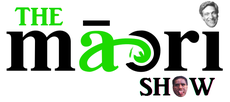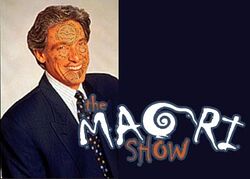The Maori Show
| The Māori Show | |

| |
| Directed by | Quentin Tarantino |
| Concept by | Tariana Turia |
| Starring | Maury Povich, the exploited Native Maori |
| Produced by | X-Ploitation Industries |
| Distributed by | A few guys with CD stalls in New Jersey |
| Air date | 7 July 2004 |
| Runtime | 3600 sec. |
| Language | English, Creole |
| Budget | The tears of the Māori people |
“We are just a simple folk making our way in the universe”
The Maori Show was a daytime television talk show which focused on the indigenous population of New Zealand, attempting to deal with important aspects of Maori culture such as teenage pregnancy, sexual infidelity, paternity test results, uncommon illnesses, makeovers, "out of control" teenagers, transgendered individuals, obese children, men controlling and abusing women, little people, bullying, and unusual phobias.
Use of Lie-detector Tests[edit]
| “ | You are not my Tamaiti's Pāpā! | ” |
The show received a record number of complaints during its syndication do to the regular use of a lie-detector which doubled as an electro-shock generator. The device was frequently used during sexual infidelity stories and occasionally within paternity testing despite strong condemnation by Amnesty International. That electrodes were attached to the wearer's temples (and/or genitals) made the device more of a "forced truth-telling machine" as participants would be electrocuted if thought to be lying.
The lie detecting sessions often took hours as many participants passed out due to the excruciating pain or were left in a permanent vegetative state. As a result, show producers used these individuals as guests in episodes revolving around euthanasia. Also controversial was the inclusion of only three categories of responses: "dishonest", "lying", and "probable deception detected or something short of the truth, we think".
Show themes[edit]
Paternity testing[edit]
Many Maori men had their lives improved as The Maori Show held them accountable for their chromosome contribution(s). One episode featured a bizarre situation between a Tane-Mahuta, his wife Hine-ahu-one and their daughter Hinetitama. A follow up show reveals the shame that Hinetitama felt on discovering Tane to be the father of her numerous daughters and the depths of hell to which she was subjected.
Unruly children[edit]
Many Maori children had their lives improved as The Maori Show demonstrated the importance of maintaining cultural traditions through the lens of popular culture over personal freedoms and modern living. We should like to point out that only a small minority of Maori children can be considered unruly, and that the vast majority are happy to exist without access to the trappings of modern life such as mobile phones, electricity and sanitation. Because of this, many of the "unruly children" that first appeared on the show were perceived as too tame by audiences. To remedy this, show producers forced child guests to drop out of high school, listen to rap music, get jumped into the Rolling 80's Crips, and smoke crack cocaine for three consecutive months prior to appearing on the show. Maori parent paid lots of money and, desperate for help for their unruly children, signed stacks of liability and consent forms so that this could be legally done.
Cultural stripmining[edit]
One particularly memorable show focused on the dominant white New Zealander's appropriation of sacred Maori beliefs and practices into a Disneyfied version utilised within the nation's tourist traps and major sporting events. Hilarity ensued.


